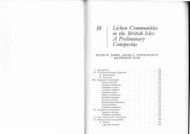Create successful ePaper yourself
Turn your PDF publications into a flip-book with our unique Google optimized e-Paper software.
thickening from the remaining cells; site <strong>of</strong><br />
nitrogen fixation.<br />
hymenial algae: algae which are in the interior <strong>of</strong><br />
the hymenium <strong>of</strong> perithecia and become ejected<br />
with the spores, smaller than the remaining algae.<br />
hymenial gelatin: gelatin-like filling material in<br />
the hymenium, cementing paraphyses etc.<br />
hymenium: layer <strong>of</strong> paraphyses and asci in the<br />
fruiting body <strong>of</strong> lichens (fungi).<br />
hyphae: filamentous organs, <strong>of</strong> which fungus or<br />
for the most part even the lichens are<br />
constructed, producing dense tissues in lichen<br />
thallus or in the fungus fruiting body.<br />
hypothallus: spongy tissue <strong>of</strong> the underside <strong>of</strong><br />
many foliose lichens.<br />
hypothecium: region within the hymenium.<br />
inspersed: (hymenium) having fine oil droplets.<br />
involucrellum: the receptacle partially or<br />
completely surrounding a perithecium, <strong>of</strong>ten a<br />
dark colored envelop or ± covering layer <strong>of</strong> the<br />
apex <strong>of</strong> the perithecium.<br />
isidium: warty, peg-form, coralloid branching or<br />
± spherical outgrowths <strong>of</strong> the thallus upper<br />
surface, used for vegetative reproduction.<br />
isidiate: with isidia.<br />
isotomic: in the case <strong>of</strong> branching; the branching<br />
equally strong and growing uniformly.<br />
core: interior <strong>of</strong> a perithecium.<br />
conidia: asexual reproductive body, e.g.<br />
produced in the pycnidia.<br />
capitate soralia: spherical soralia on the ends <strong>of</strong><br />
the lobes.<br />
coraloid: coral-like, i.e. <strong>of</strong> cylindric branching<br />
segments.<br />
crustose lichen: lichens one with the substrate<br />
lying closely bound crust-like, coherent, areolate<br />
or ± squamulose thallus, not or scarcely able to<br />
loosen without destroying.<br />
cryptolecanorine: apothecia sunken into the<br />
thallus, bordered by the thallus, but without a<br />
thalloid margin (set <strong>of</strong>f).<br />
spherical soralia: (capitate or laminal): ±<br />
spherical soralia on the upper surface <strong>of</strong> the<br />
thallus.<br />
Kurzzweig: short unbranched side branches.<br />
thalloid margin (thalline exciple): produced by<br />
the thallus and commonly ± thallus colored algae<br />
containing border <strong>of</strong> an apothecium.<br />
Laubflechte : foliose lichen.<br />
lecanorine: apothecium with thalloid margin.<br />
lecideine: apothecium with black proper margin.<br />
leprose: thallus completely erupted dusty,<br />
without cortex.<br />
lichenized: producing a lichen, i.e. the fungus is<br />
associated with algae, or algae with a fungus.<br />
lip soralia (labriform) lip-form curved soralia on<br />
the underside <strong>of</strong> the lobe end.<br />
lirellae: long narrow apothecia.<br />
macroconidia: in the case <strong>of</strong> species with at least<br />
two conidia forms (pycnospore forms) the larger<br />
conidia type.<br />
collar soralia: in the case <strong>of</strong> soralia, the ring<br />
form produced around a hole.<br />
medulla: loose hyphal tissue underneath the algal<br />
layer.<br />
muriform: cross and longitudinally divided spore;<br />
weakly muriform: with less cells.<br />
mazaedium: dusty mass <strong>of</strong> spores and remains <strong>of</strong><br />
asci and sometimes also paraphyses, covering the<br />
fruiting body.<br />
mesoconidia: in the case <strong>of</strong> species with at least<br />
three conidia forms (pycnospore forms) the<br />
middle sized conidia type.<br />
micareoid: algae small (4-7 µm), thin-walled,<br />
<strong>of</strong>ten in pairs (in the case <strong>of</strong> Micarea).<br />
microconidia: in the case <strong>of</strong> species with at least<br />
two conidia forms (pycnospore forms) the<br />
smaller conidia type.<br />
modification: environmental influenced, non<br />
hereditary change.<br />
navel (umbilicus): ± central, <strong>of</strong>ten single<br />
attachment <strong>of</strong> a foliose lichen, also a pointed<br />
nipple-like outgrowth <strong>of</strong> the disk <strong>of</strong> an<br />
apothecium.<br />
navel lichen (umbilicate lichen): foliose lichen<br />
attached with a navel.<br />
needle-form (acicular): in the case <strong>of</strong> spores:<br />
long, narrow, long pointed on one end.<br />
net-ribbed (reticulately ridged): upper surface<br />
divided by weakly raised ridges surrounding<br />
weakly concave regions.<br />
ocular chamber: short finger-like projections <strong>of</strong><br />
the ascus interior region into the (inner) wall <strong>of</strong><br />
the ascus tip.<br />
ostiole: pore-form opening at the apex <strong>of</strong> the<br />
perithecium.<br />
palisade parenchyma: tissue, whose hyphae are<br />
oriented ± at right angles to the upper surface.<br />
papillae: small, usually ± regularly round,<br />
convex outgrowths <strong>of</strong> the thallus, not sharply<br />
separated from isidia.<br />
parallel multicellular (septate): spores in the<br />
case <strong>of</strong> 3 or more ordered one behind the other.<br />
paraphyses: filamentous, branched or<br />
unbranched, usually vertical ordered hyphae in<br />
the hymenium, attached at the base.<br />
30





